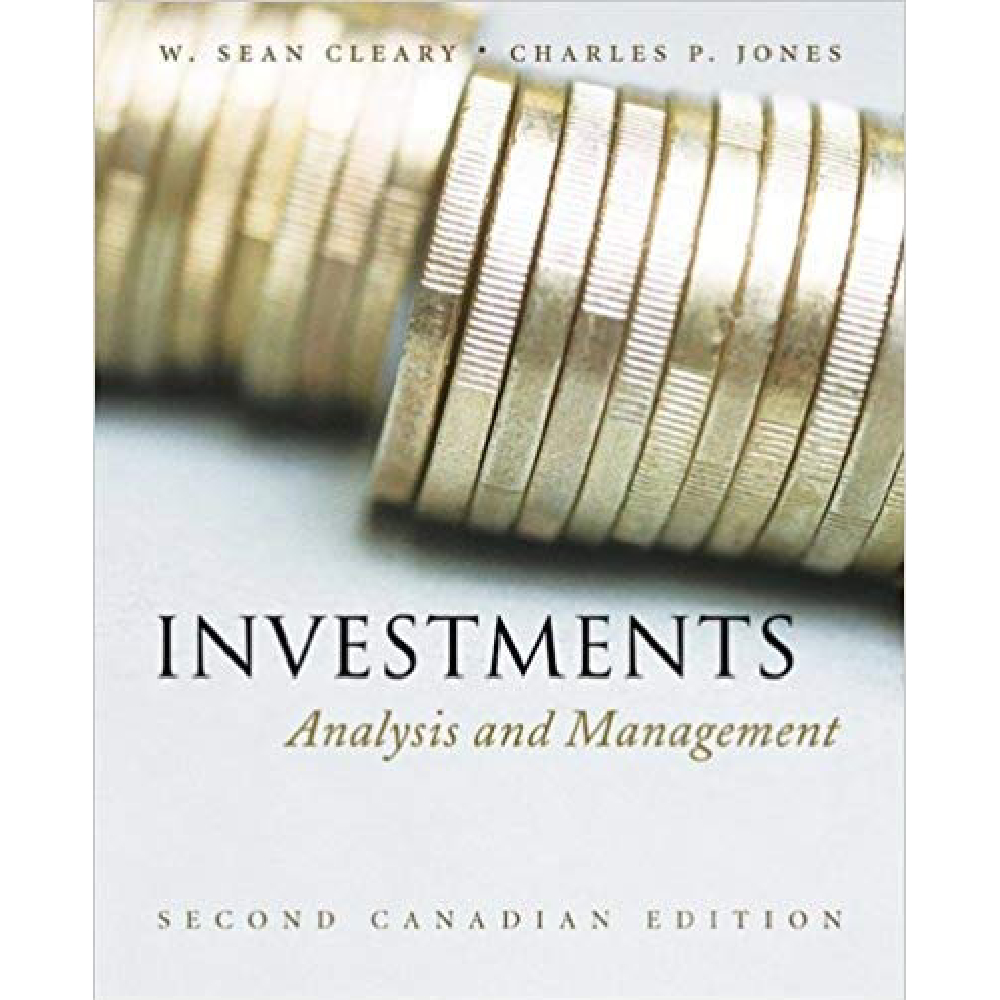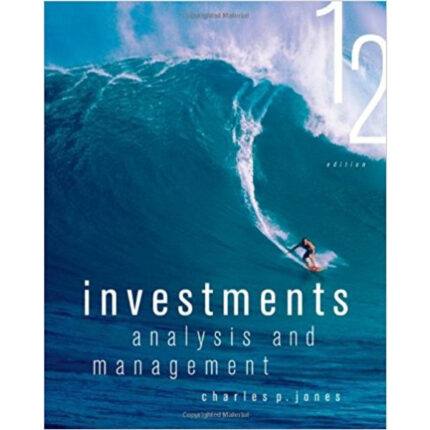Investments Analysis And Management 3rd Canadian Edition By W. Sean Cleary – Test Bank
CHAPTER 11
Bond Yields and Prices
MULTIPLE CHOICE
1. A bond’s intrinsic value is:
a. another name for par value.
b. the value that the bond will pay to the bondholder at maturity.
c. the present value of the expected cash flows to be received from the bond.
d. the amount by which the market value exceeds the par value of the bond.
Answer: c
Topic: Bond Prices: The Valuation Principle
Level of Difficulty: Easy
Type: Factual
2. Subtracting the inflation rate from the market interest rate results in an approximate:
a. inflation-adjusted rate of interest.
b. real risk-free rate of interest.
c. real risky rate of interest.
d. inflation-adjusted yield
Answer: b
Topic: Bond Yields: The Basic Components of Interest Rates
Level of Difficulty: Moderate
Type: Conceptual
3. The bond market in Canada is dominated by:
a. corporate issues.
b. provincial government bonds, especially Alberta.
c. government of Canada bonds.
d. foreign bonds.
Answer: c
Topic: Bond Prices: The Valuation Principle
Level of Difficulty: Moderate
Type: Factual
4. Under the Fisher hypothesis, inflation rate were expected to increase by 50 basis points, nominal
rates on short-term securities would:
a. rise by 50 basis points since inflation and nominal rates are directly related.
b. fall by 50 basis points since inflation and nominal rates are inversely related.
c. fall by less 50 basis points since the Fisher hypothesis assumes a slow speed of adjustment to
economic news.
d. rise by less than 50 basis points since the Fisher hypothesis assumes market inefficiency.
Answer: a
Topic: Bond Yields: The Basic Components of Interest Rates
Level of Difficulty: Moderate
Type: Conceptual
5. Which of the following regarding the current yield on a bond is not true?
a. The current yield is superior to the coupon rate because it uses market price instead of face
value.
b. The current yield is equal to the coupon rate if the bond is trading at par. .
c. The current yield does not account for difference between purchase price and redemption value.
d. The current yield shows the bond’s expected rate of return if held to maturity.
Answer: d
Topic: Bond Yields: Measuring Bond Yields
Test Bank
1
Chapter 11
Copyright © 2009 John Wiley & Sons Canada, Ltd. Unauthorized copying, distribution, or transmission is strictly prohibited.
Chapter 11: Bond Yields and Prices
Level of Difficulty: Moderate
Type: Conceptual
6. The yield to maturity for a bond:
a. like the current yield takes into account only the interest income payable on the bond.
b. is calculated in the same way as the IRR for a capital budgeting project.
c. will always be greater than the yield to call since the time horizon is longer.
d. does not take into account the reinvestment of interest income from the bond.
Answer: b
Topic: Bond Yields: Measuring Bond Yields
Level of Difficulty: Moderate
Type: Conceptual
7. In order to have a yield to maturity less than the coupon rate, the bond must be:
a. selling at a discount.
b. selling at par.
c. selling at a premium.
d. a zero coupon bond.
Answer: c
Topic: Bond Yields: Measuring Bond Yields
Level of Difficulty: Moderate
Type: Conceptual
8.
A yield to call calculation:
a. is best used when the bond is trading at par.
b. is the same as the YTM but uses the last period in which the bond can be called prior to
maturity.
c. is best used for high coupon bonds trading at a premium.
d. is only applicable to bonds that have already been called for redemption.
Answer: c
Topic: Bond Yields: Measuring Bond Yields
Level of Difficulty: Moderate
Type: Factual
9. When interest rates decrease:
a. bond prices rise.
b. bond prices fall.
c. prices of newly issued bonds are lowered.
d. interest rates of existing bonds are raised.
Answer: a
Topic: Bond Price Changes: Bond Price Changes as a Result of Interest Rate
Changes
Level of Difficulty: Easy
Type: Factual
10. If a bond is callable, this means:
a. the issuing company may extend the maturity date.
b. the bondholder may sell the bond back to the company prior to maturity at her option.
c. the issuing company can require the bondholder to sell the bonds back to the company prior to
maturity.
d. the bondholder can convert the bond into the issuing company’s stock at any time at any time
prior to maturity.
Answer: c
Topic: Bond Yields: Measuring Bond Yields
Level of Difficulty: Easy
Type: Factual
11. A deferred call provision means:
a. the bond cannot be called before a certain time.
b. the bond pays interest on a deferred basis.
c. the bond is called only in the last year of the term.
d. the shareholders must defer to the bondholders regarding the call date.
Answer: a
Topic: Bond Yields: Measuring Bond Yields
2
Cleary/Jones
Level of Difficulty: Moderate
Investments: Analysis and Management, Third Canadian Edition
Type: Factual
12. For most bonds the coupon rate is stated:
a. as an annual percent and paid annually.
b. as an annual percent and paid semi-annually.
c. as a semi-annual percent and paid annually.
d. as a semi-annual percent and paid semi-annually.
Answer: b
Topic: Bond Yields: Measuring Bond Yields
Level of Difficulty: Easy
Type: Factual
13. Which of the following statements regarding changes in bond prices relative to changes in market
yields is true?
a. Short-term bond prices will increase more than long-term bond prices if market yields increase.
b. Short-term bond prices will increase less than long-term bond prices if market yields decrease.
c. Short-term bond prices will increase more than long-term bond prices if market yields decrease.
d. Short-term bond prices will remain constant and long-term bond prices will increase if market
yields decrease.
Answer: b
Topic: Bond Price Changes: Bond Price Changes Over Time
Level of Difficulty: Difficult
Type: Factual
14. Which of the following bonds would you expect to have the lowest price volatility?
a. 8%, 20 year bond
b. 8%, 10 year bond
c. 4%, 20 year bond
d. 4%, 10 year bond
Answer: b
Topic: Bond Price Changes: Measuring Bond Price Volatility: Duration
Level of Difficulty: Difficult
Type: Factual
15.
Duration was designed to:
a. provide a better method to calculate the intrinsic value of a bond.
b. provide bond portfolio managers a method of determining the effect of yield changes on the
prices and rates of return for different bonds.
c. provide a way of reconciling computational differences between current yield, yield to call and
yield to maturity for different bonds.
d. provide bond managers with a method of pricing bond swap strategies.
Answer: c
Topic: Bond Price Changes: Measuring Bond Price Volatility: Duration
Level of Difficulty: Moderate
Type: Conceptual
16. The duration of a zero-coupon bond:
a. will be greater than the duration of a coupon bond with the same maturity.
b. will be less than the duration a coupon bond with the same maturity.
c. will be equal to the duration of a coupon bond with the same maturity.
d. is impossible to determine.
Answer: a
Topic: Bond Price Changes: Measuring Bond Price Volatility: Duration
Level of Difficulty: Moderate Type: Conceptual
17. Assuming that interest rates do not change over the remaining life of a bond which of the following
will not occur?
a. discount bonds will increase in price as maturity approaches
b. premium bonds will decrease in price as maturity increases
c. par bonds will become more volatile in price as maturity approaches
Test Bank
3
Chapter 11
Copyright © 2009 John Wiley & Sons Canada, Ltd. Unauthorized copying, distribution, or transmission is strictly prohibited.













Reviews
There are no reviews yet.